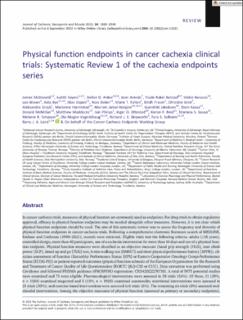| dc.description.abstract | In cancer cachexia trials, measures of physical function are commonly used as endpoints. For drug trials to obtain regulatory approval, efficacy in physical function endpoints may be needed alongside other measures. However, it is not clear which physical function endpoints should be used. The aim of this systematic review was to assess the frequency and diversity of physical function endpoints in cancer cachexia trials. Following a comprehensive electronic literature search of MEDLINE, Embase and Cochrane (1990–2021), records were retrieved. Eligible trials met the following criteria: adults (≥18 years), controlled design, more than 40 participants, use of a cachexia intervention for more than 14 days and use of a physical func- tion endpoint. Physical function measures were classified as an objective measure (hand grip strength [HGS], stair climb power [SCP], timed up and go [TUG] test, 6-min walking test [6MWT] and short physical performance battery [SPPB]), cli- nician assessment of function (Karnofsky Performance Status [KPS] or Eastern Cooperative Oncology Group-Performance Status [ECOG-PS]) or patient-reported outcomes (physical function subscale of the European Organisation for the Research and Treatment of Cancer Quality of Life Questionnaires [EORTC QLQ-C30 or C15]). Data extraction was performed using Covidence and followed PRISMA guidance (PROSPERO registration: CRD42022276710). A total of 5975 potential studies were examined and 71 were eligible. Pharmacological interventions were assessed in 38 trials (54%). Of these, 11 (29%, n = 1184) examined megestrol and 5 (13%, n = 1928) examined anamorelin; nutritional interventions were assessed in 21 trials (30%); and exercise-based interventions were assessed in 6 trials (8%). The remaining six trials (8%) assessed mul- timodal interventions. Among the objective measures of physical function (assessed as primary or secondary endpoints), HGS was most commonly examined (33 trials, n = 5081) and demonstrated a statistically significant finding in 12 (36%) trials (n = 2091). The 6MWT was assessed in 12 trials (n = 1074) and was statistically significant in 4 (33%) trials (n = 403), whereas SCP, TUG and SPPB were each assessed in 3 trials. KPS was more commonly assessed than the newer ECOG-PS (16 vs. 9 trials), and patient-reported EORTC QLQ-C30 physical function was reported in 25 trials. HGS is the most commonly used physical function endpoint in cancer cachexia clinical trials. However, heterogeneity in study design, popu- lations, intervention and endpoint selection make it difficult to comment on the optimal endpoint and how to measure this. We offer several recommendations/considerations to improve the design of future clinical trials in cancer cachexia. | en_US |

